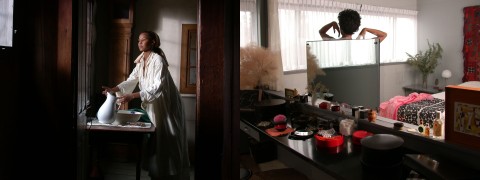Brooklyn-based artist Lorna Simpson has developed a poetic and political body of work that focuses on the politics of black identity, culture, and history through the lens of conceptual film and photography. She rose to prominence soon after receiving her BFA from the School of Visual Arts in New York and her MFA in photography from UC San Diego with a series of large-scale monochromatic and text-based photographs from the late 1980s and early 1990s. Employing the repetition and fragmentation of various signifiers of race and gender, the images subtly challenge the professed universalism of artistic forms and the objectivity of viewers, an approach that Simpson eventually would extend to various media.
Often referred to as “anti-portraits,” her early works feature black female models with their backs turned to viewers or their faces outside of the frame as ambiguous, non-narrative text borders the images. According to Dr. Kellie Jones, the women appear to be "rejecting any familiarity, yet communicating with us feverishly in accompanying written messages” . . . However, they refuse to offer simplistic narratives or conclusive readings. For example, _Tense_ (1991) depicts a black woman and an African mask turned away from the viewer with a caption that reads, “present / past imperfect / present imperfect / past perfect / future perfect." In effect, _Tense_ recalls and rejects the historical and ongoing display of African women and artifacts as commodities and curiosities. As a form of resistance, the work proposes alternative views of its subjects, both literally and figuratively.
By the mid-1990s, Simpson began her “Public Sex” series of panoramic-scale, multi-panel photographs printed on felt. The works feature urban landscapes or empty interiors accompanied by labels that supply narration or interior monologues. The texts evocatively describe encounters of desire, wonder, and intrigue that Simpson characteristically refuses to picture. Nonetheless, the absence of figures ironically allows for a more intimate engagement with the subjects.
During the late 1990s, Simpson ventured into film and video installations. By focusing on the figure as a moving image, she was able to capture the intricacies of being black and female and expand the complexity and narrativity of her practice. Nonetheless, with unexplained context and relationships for her characters as well as incongruent scenes juxtaposed both visually and temporally, her scenarios remained purposefully vague. In particular, _31_ (2002) presents a grid of thirty-one small screens, each of which follows an anonymous young black woman from morning to night on a particular day in one month or out of thirty-one days. _Call Waiting_ (1997) observes a series of phone conversations held among several different black, Asian, and Latino men and women, all of whom seem to be involved with each other on various levels. As conversations take place between friends, they are interrupted by calls from other friends, which are also interrupted. The numerous takes and incomplete sequences exemplify Simpson's refusal to impose definitive claims on the world that her characters and viewers inhabit.
By the late 2000s, Simpson returned to photography. However, rather than her own, she presented found imagery in wall installations that include _Photobooth_ (2008)—a collection of small framed images of African American men taken in photo booths during a critical moment of transition, the Black Migration. As a large black population moved from southern to northern states to find new forms of employment, they also “found” new identities. With the models now facing forward, _Photobooth_'s portraits demonstrate the various ways in which the men saw themselves and desired to be seen, rather than how others perceived them.
_Corridor_ (2006) also refers to critical periods in U.S. history, particularly for African Americans—the Civil War and Civil Rights eras. However, the work does so via the daily routine of two black women, both of whom are portrayed by the artist Wangechi Mutu. Although the film is specific in its depiction of the styles, interiors, and technology of the two periods, nothing specific occurs. Simpson invites the viewer to focus on the psychological disposition of the women as they move through the corridors of their respective homes. The work thereby suggests that history comprises individual lives, rather than a series of constructed narratives.
On the left side of a split screen, Mutu appears as a house servant in 1860—the year of Abraham Lincoln's presidential election—and on the right, she plays a well-heeled housewife in 1960—the year in which John F. Kennedy became president. Both characters bathe, dress, and clean during the day, and upon nightfall, one woman writes a letter as the other places a telephone call. They do nothing spectacular or stereotypical as they go about their routines in manners similar to each other and perhaps their viewers. Nonetheless, despite their similarities, the women are separated by a century, which is indicated by various instances of formal tension: the split screen and their dissimilar settings as well as the discord from two soundtracks—free jazz and a battle hymn by black composers Albert Ayler and “Blind Tom” Wiggins, respectively—that play simultaneously.
Moreover, the work recalls dual notions of a corridor. In one sense, it is an area identified by a specific purpose or characteristic. Therefore, the women's similar domestic routines might suggest that the more things change, the more they stay the same, particularly for gender roles. At the same time, a corridor is also a passageway that opens onto other areas. As each historical moment of change in the U.S. gave way to new opportunities for and further transformation of its citizens, the difference between the characters' socioeconomic statuses suggests the great progress made by African Americans.
The concurrence of these divergent interpretations ultimately speaks to the intersectionality of black women. That is, _Corridor_ evokes the overlap, and sometimes contradictory effects, of such aspects of identity as race, class, and gender. Further, like Simpson's works, such ambiguous experiences cannot be explained by or forced into a simplistic narrative. _—Kanitra Fletcher_

